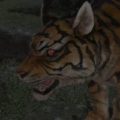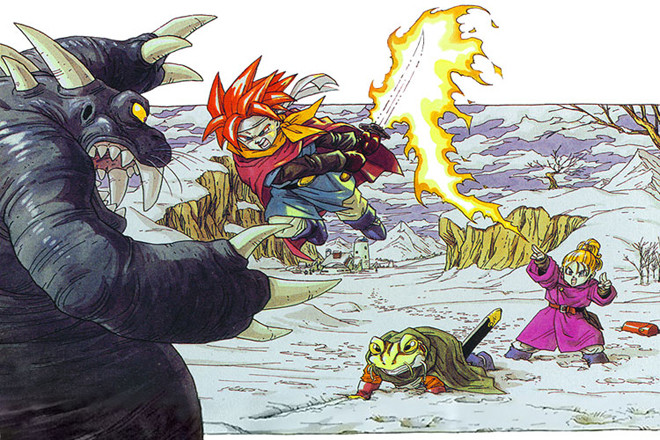Random Roar: Failure is the Only Option

My ongoing project for the blog is a series of RPG retrospective articles currently covering Final Fantasy and Dragon Quest and which will eventually come back to Kingdom Hearts once I make it to the PlayStation 2 era. You might think this is a straightforward project, but as we enter the era of Kingdom Hearts, we begin to see more spin-off titles for Final Fantasy and Dragon Quest. So far, there haven’t been a substantial number of Kingdom Hearts spin-off projects to keep track of since every game released in the franchise history (with the exception of V CAST) ties into Tetsuya Nomura’s larger narrative and thus by definition, he has to be involved in all of them. It prevents the kind of explosion of games we get from other franchises, like the Compilation of Final Fantasy VII, the World of Mana and more.
But as I said, there are a ton of spin-off titles for Final Fantasy and Dragon Quest and this is going to complicate my Retrospective project in a number of ways. I want to talk about how the games have been evolving and how the spin-off titles contribute to that, but for several reasons, I think this project will never cover all of Final Fantasy or all of Dragon Quest.
1. Not every game is still available
As readers of this blog know, Mobius Final Fantasy shut down at 1:00AM Pacific on June 30, 2020. It is now impossible to continue to play the game, no matter how much unfinished business you might have with it.
This isn’t the only game that has vanished. Dragon Quest of the Stars shut down about a year after it finally came to North America, which makes you wonder why they bothered to put the effort into translating it in the first place. It had originally been released in 2015 and was finally available in English in 2020. Final Fantasy XV had a digitally released Platinum Demo which was only available for a year and featured events that did not show up in the actual game. Certain games like Final Fantasy Tactics S were mobile games which were terminated shortly after release, and then there are games like Before Crisis: Final Fantasy VII which exist as part of the lore of Final Fantasy VII but which has only ever been available in Japan on specific cell phone technology back before Android and iOS standardized everything. Later this month, Before Crisis is going to be celebrating seventeen years of being Japanese exclusive. The chances that it’s still available are slim, if there even still exists someone with a phone that can access it.
Before Crisis brings up another good point.
2. Not every game is available in English
This has been a huge set-back when it comes to a series like Dragon Quest, which has been struggling to get noticed in the West. Dragon Quest VIII looked like it was going to start a trend where the series would finally get the recognition it deserved and we wouldn’t miss out on games ever again… but we were passed over for Dragon Quest Monsters: Joker 3, we lost out on a few remakes and we also famously have yet to receive an official English version of Dragon Quest X, and even the “offline” version has yet to be confirmed for us.
There’s also only so far a translation patch will get us. The original SNES version of Dragon Quest VI is probably one of the most high profile RPGs to have never been fully translated. The translation patch everyone uses has all of the main game translated, with some random strings of Japanese left over. It also introduces a fatal crashing bug that was never fixed by the team who released the patch in the twenty years since it was made available. Instead, the version that is likely the best one to play is probably the official Nintendo DS release, which was fully translated.
This has also been a set-back for Before Crisis, since in order to translate the game, someone needs to acquire it in such a way to be able to dump the script (or reliably find a way to work with the script as they play), and then if everyone else wants to experience the game, they’ll need a way to acquire the game, and as far as I can tell, you can’t even steal the game right now, let alone buy it. Fans have been so desperate to experience the game that one person who still had his copy did his best to recreate it in English in RPGMaker.
3. Not every spin-off is notable
Be honest. Do you really expect me to cover Final Fantasy VII G-Bike? Many games released in the Final Fantasy and Dragon Quest franchises only exist so that the mobile market will always have a few active games each, and thus continue to funnel money into Square Enix from long time fans of either series who are waiting for the next actual console game to come out and have nothing better to do with their time. A few games are actually worth playing, like Record Keeper and Brave Exvius, but the vast majority aren’t, so it’s lucky for us that most of them have never been released outside of Japan.
But there are many spin-off titles that have been released in North America, and not all of them are made equal. I can see myself covering the Chocobo’s Dungeon games, but I don’t know if Chocobo Racing should be covered. I’m pretty sure it doesn’t move the Final Fantasy series forward in any meaningful manner, and it never got a sequel. Should I cover the Itadaki Street games? Should I cover Dissidia? Actually, that brings up another good point.
4. Final Fantasy is littered with nostalgic spin-offs
If you’ve played one, you’ve played… one. I have to hand it to Final Fantasy, they’ve discovered ways to repackage nostalgia in such a way that you want to buy it again and again. Dissidia brings together characters from Final Fantasy into a fighting arena as heroes and villains face off against one another in an eternal battle between Cosmos and Chaos. World of Final Fantasy brings together characters from Final Fantasy into a turn-based RPG starring a pair of characters who wouldn’t look out of place in a Kingdom Hearts cosplay event. Final Fantasy XIV is largely an original world with original characters which still uses references, locations, and even new versions of characters from past games in the series in a nostalgic nod for players; the entire fanbase went nuts when Minfilia name dropped Krile for the first time. Kingdom Hearts brings characters from certain Final Fantasy games together as supporting characters in Sora’s journey to become a Keyblade master. Mobius Final Fantasy brought characters from certain Final Fantasy games into special crossover events and in at least one case, the event was meant to be canon to the original game. Even the main series features call-backs on a regular basis, from Cid being in every game and retroactively appearing in the first, to creatures like chocobos and moogles showing up often, and even characters from past games are sometimes referenced. Final Fantasy Tactics features the actual Cloud Strife (and the remake features the actual Balthier, too). A major part of the Final Fantasy franchise is definitely nostalgia.
What this means for the Retrospectives is that if I were to cover all of the games that exist to sell nostalgia to players, they’ll be different games structurally, but will feature pretty much all of the same elements. Here’s another version of Cloud Strife, here’s another version of Lightning, here’s another version of this or that, and so on.
Dragon Quest isn’t innocent in this, either. The two Dragon Quest Heroes games bring back popular characters from the past to help brand new protagonists fight threats both new and old, and Dragon Quest Builders is literally built upon nostalgia for the Erdrick trilogy. Itadaki Street brings characters from several franchises together in a board game whose levels are modeled after elements of those franchises. Dragon Quest Monsters is a game whose dungeons are partially modeled after previous games in the series, right down to several of the bosses coming from those original games. Dragon Quest‘s spin-offs also aren’t above bringing back characters from the main series to serve as the main protagonists. Dragon Quest Monsters stars Terry from Dragon Quest VI, there are several games in the Mystery Dungeon series starring Torneko from Dragon Quest IV, and so on.
5. Not every title in either series belongs to a game.
Currently airing on Japan and enjoying simultaneous release on Crunchyroll is Dragon Quest: The Adventure of Dai, a series based on the original manga, and which had already received an anime adaptation back when the manga was new. There are also several manga that exist which retell the stories of several Dragon Quest games, and one which acts as a sort of sequel to Dragon Quest Monsters.
Final Fantasy, meanwhile, has titles such as The Spirits Within, a movie which is tangentially related to Final Fantasy, Advent Children, a movie which is the direct sequel to Final Fantasy VII, Lost Stranger is a manga about a Square Enix employee and Final Fantasy megafan who finds himself Isekai’d by Truck-kun (no, really, see page 16 of Volume 1) into a Final Fantasy world that resembles the franchise’s two MMORPGs, right down to having yet more new versions of the original five races from Final Fantasy XI: Online, and so on. Since Advent Children is a Final Fantasy VII sequel, DQM+ is a Dragon Quest Monsters sequel and Legend of the Crystals takes place in the same world as Final Fantasy V, I almost feel duty-bound to talk about them sometime. But then if they make the cut, then shouldn’t I talk about other projects like Lost Stranger? Should I compare the Kingdom Hearts games to their manga?
6. The more I add to the project, the longer it’s going to take
Life’s taken me on interesting turns lately and I feel like I don’t always have the time to sit down and continue working on the Retrospectives. Someone’s always wanting a piece of my time. I would love to sit down with an ambitious project and see that ambition through to completion, but at this point, I’ve definitely taken a knife to the project and pared it down somewhat. I just don’t have the desire to spend a lot of time on stuff like Final Fantasy: World Wide Words or Dragon Quest: Monster Parade when the games aren’t even available any more and were Japanese only, since there are already plenty of games to play which I do have access to. I think I can also safely say that I wouldn’t devote much time to those games even if I did have nothing else going on in my life. I do want to see this project through to completion.
7. There are always new games being added.
The most recent Kingdom Hearts release is Melody of Memory. Final Fantasy XIV: Endwalker is coming very soon, with more Final Fantasy projects announced for the future, including Final Fantasy XVI. Dragon Quest XII has been announced, as have been several other projects, and a game based on The Adventure of Dai is also coming soon.
I’d love to determine at which point the “Retrospective” part of the project ends and I can just talk about current projects. Maybe as soon as I make it to whatever “present day” ends up being at the end of the project, I can finally call it complete. But the longer I take talking about older games, the more newer games get added to the pile.
And that’s where I am right now. There are a lot of games in the project and not a lot of time to complete it. How long will it take? At this point, I don’t know. Maybe I’ll never finish and I’ll just keep working on it until the Internet collapses and I can call it my life’s work!




